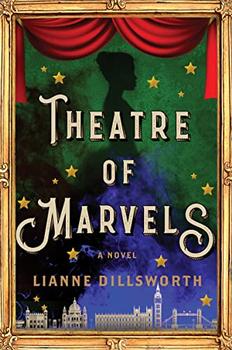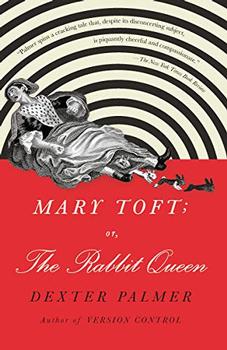Summary | Excerpt | Reviews | Beyond the book | Read-Alikes | Genres & Themes | Author Bio

In the prologue to Leslie Parry's novel, Isabelle Church, a sword-swallower, looks back with nostalgia on her life as a teenager in an 1890s sideshow. Alas, the theater her mother founded, the titular "Church of Marvels," is no more. This Coney Island landmark burned down and its performers are dead or dispersed. Now though, Belle must make a mysterious quest into New York City to find a Mrs. Bloodworth. She leaves behind her twin sister, Odile, and memories of the "freaks" they employed at the theater, including four-legged Georgette and hermaphroditic Aldovar. Before long Odile too sets off in pursuit of her sister.
Odile and Belle's story is only one strand. We also meet Sylvan Threadgill, a nineteen-year-old orphan raised by kindly glove makers. He works as a New York City night-soiler, emptying privies into a slop wagon, and picks up extra money when he wins amateur boxing matches. For his appearance as well as his job, he is an outsider: he is ethnically indeterminate and people call him by a derogatory nickname "Dogboy." One night Sylvan finds a live baby girl shoved down a privy and takes her home.
A third storyline follows Alphie, whose Italian mother-in-law has had her committed to a mental asylum on Blackwell's Island (now renamed Roosevelt Island). She used to make a living as a "Penny Rembrandt" street portraitist and makeup artist – as well as a part-time prostitute – until she married Anthony, an undertaker. All Alphie ever wanted was a child, but for her and Anthony it would take heroic, even devious measures. Now, at the asylum, she meets Orchard Broome, a mute girl who is willing to help her escape.
Why is Alphie in a mental asylum at all? Who bore the baby that Sylvan found down the privy? And what could possibly link all of these stories? Parry pulls everything together in a surprising, ambitious plot worthy of Dickens (to whose Oliver Twist this novel bears a more than passing resemblance). She recreates many vivid settings; in addition to the asylum, theater, privies, and glovers' shop, there's a brothel, an oyster factory, the opium den Anthony frequents, and the floating church where Sylvan loses a fight. You feel like you can see and even smell all these places thanks to Parry's excellent use of sensory detail.
This is a very dark vision of Victorian life. There are macabre touches everywhere, including wooden hand models in the glovers' shop and a girl with a wooden arm. Anthony's mother collects a tooth from each corpse her son handles, and a major character loses a tongue. From slop wagons to menstrual rags, Parry does not shy away from the muck of everyday life. Moreover, a number of her characters were considered sexual deviants at that time.
Parry's inventive metaphorical language – often reliant on food – is one of the novel's highlights. She shows us "a dimpled chin like a pat of butter someone had stuck their thumb in" and eyes either "bulging like two boiled eggs from their sockets" or "as sunken and black as a potato's." With just a handful of words, she captures so much about a person or a place, as in "the peanut-cracking babel of the boardwalk" or "the Signora, all talcum and licorice."
For as impressive as I found the plotting and language, I was slightly unsatisfied with the characterization. Because the story is divided between three sets of characters, I felt I never got to know some of the main figures, especially Odile, as well as I might like. The kitchen-sink approach to the plot means Parry has to spend a lot of time tying up loose ends, whereas if there were fewer characters and subplots she could have focused on exploring them more deeply.
Nevertheless, this is a very atmospheric and accomplished debut novel. Especially with its gender-bending and focus on genetic oddities, it should hold a lot of appeal for fans of Sarah Waters (Fingersmith), Angela Carter (Nights at the Circus), and Alice Hoffman (The Museum of Extraordinary Things). Circus and sideshow themes have been very popular in fiction in recent years, and this is a great example of a novel that uses those elements as background but goes beyond the incidentals of the carnival lifestyle to examine sexuality and societal outcasts.
![]() This review was originally published in The BookBrowse Review in June 2015, and has been updated for the
May 2016 edition.
Click here to go to this issue.
This review was originally published in The BookBrowse Review in June 2015, and has been updated for the
May 2016 edition.
Click here to go to this issue.

If you liked Church of Marvels, try these:

by Lianne Dillsworth
Published 2023
Set amid the bustle of Victorian London, an irresistible story of an ambitious young Black actress, an orphan from the slums who has finally achieved a dubious stardom as "The Great Amazonia, a savage African queen" - but everything she has fought for depends on hiding the secret of her own identity.

Mary Toft; or, The Rabbit Queen
by Dexter Palmer
Published 2020
In 1726, in the town of Godalming, England, a woman confounded the nation's medical community by giving birth to seventeen rabbits. This astonishing true story is the basis for Dexter Palmer's stunning, powerfully evocative new novel.
Your guide toexceptional books
BookBrowse seeks out and recommends the best in contemporary fiction and nonfiction—books that not only engage and entertain but also deepen our understanding of ourselves and the world around us.